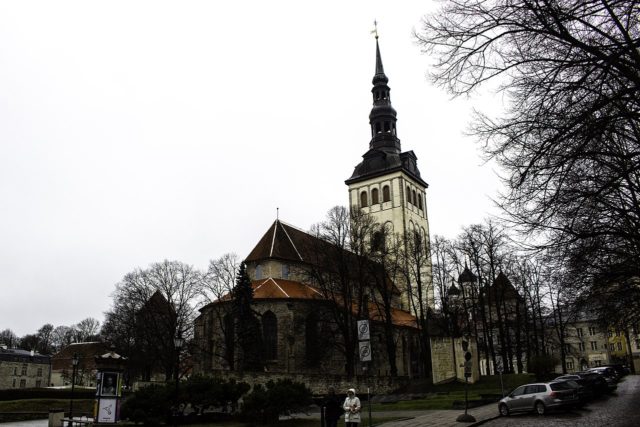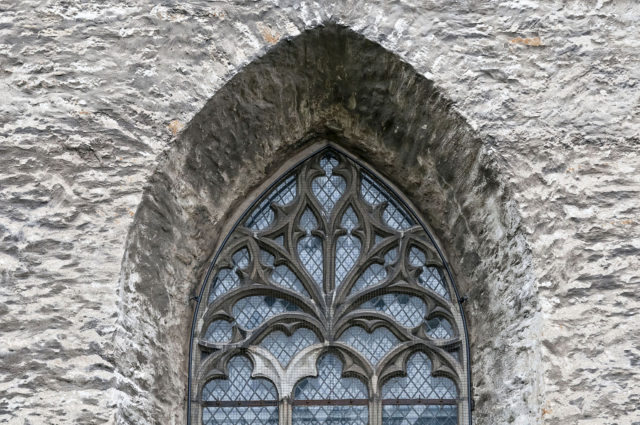Niguliste Muuseum
Very close to the museum of Orders of Knighthood is Niguliste Muuseum (St. Nicholas’ Church). St. Nicholas’ Church was one of the two parish churches in medieval Tallinn and one of the wealthiest churches in the town. Consecrated to the patron saint of merchants and seafarers, St. Nicholas, it is believed to have been founded in the middle of the 13th century.
By the end of the century, a three-aisled nave, a sacristy on the north side of the chancel, and the lower part of the western tower were added. Several chapels were built on the northern side of the church in the 14th century, including St. George’s Chapel, located on the site of the present North Hall, and the Small Chapel, which was linked to the northern aisle by two high arched openings. St Matthew’s Chapel was erected on the southern side of the tower.
A more thorough rebuilding of the church was undertaken in the 15th century. The construction work lasted from 1405 to 1420 and gave the chancel and the nave their current appearance. On the site of the old chancel, a new one was established, which was of the same width as the nave, and had a polygonal apse and an ambulatory around it. The walls of the church aisles, as well as the nave, were made higher and the church was rebuilt as a basilica. From 1486 to 1493, St Matthew’s Chapel was fully rebuilt (renamed St Anthony’s Chapel in the 17th century), becoming a spacious room with a groined vault and a central pillar.


During the Middle Ages, St. Nicholas’ was one of the town’s most magnificent churches. At the beginning of the 16th century, more than 20 side altars were located there. The glory of the Hanseatic times and the prosperity of the local merchants are expressed in its valuable works of art, commissioned from the large art centers of Europe.
Among the most noteworthy ones are Bernt Notke’s Danse Macabre and the magnificent retable of the high altar from the workshop of Hermen Rode, both works of Lübeck masters from the Late Middle Ages, which can still be viewed in the church. Valuable liturgical silver could also be found in the church. A seven-armed brass candelabrum, almost four meters high, donated to the church at the beginning of the 16th century, can still be admired in St. Nicholas’. It is one of the largest of its kind in the world. At the beginning of the 1520s, the first evangelical preachers reached Tallinn.



The Reformation, started by Martin Luther, received the support of the local municipality at an early stage and the reorganization of the ecclesiastical life was started. St. Nicholas’ Church became a Lutheran congregation church. In the middle of the 16th century, St. Nicholas’ Church received pews for the congregation in the Renaissance style, with a Lutheran pictorial program, depicting characters from the Old and the New Testaments. In the mid-17th century, balconies for the congregation were commissioned for the church.
The pulpit, donated in 1624, depicting scenes from the life of Christ, was among the most exquisite samples in Estonia. Epitaphs and coat-of-arms epitaphs were set on the walls to commemorate the wealthy citizens, noblemen, and pastors buried in the church. During the 17th and 18th centuries, memorial chapels were erected on the northern side of the church, dedicated to Bogislaus von Rosen (1651), Gustav Adolf Clodt (1673), and Peter August von Holstein-Beck (1773). The Chapel of St. George was transformed into the North Hall.
The Second World War caused enormous destruction to St. Nicholas’ Church. As early as 1943, the evacuation of the valuable art had begun, perhaps foreseeing the course of events. However, only a few of them were saved from the destruction of the war. During the bombing on 9 March 1944, the church was hit and almost everything that was left in the building was destroyed by fire. Therefore, the beautiful pews and balconies of the church are gone for good, along with the pulpit and several epitaphs. The reconstruction of St. Nicholas’ Church started in 1953. In 1984, after nearly thirty years of restoration, the building, having been adjusted to the needs of a museum and a concert hall, was opened as a branch of the Art Museum of Estonia.


The collection of the Art Museum of Estonia, founded in 1919, was formed in the course of almost a century. The majority of the church art was collected in the 1920s and 1930s. After the Second World War, works of ecclesiastical art from other museums and churches of Estonia were added to the collections, yet most of the exhibits in the Niguliste Museum originate from St. Nicholas’ Church. The Niguliste Museum is one of the few northern European museums located in a former church, where ecclesiastical art can be enjoyed in its historical context. Late medieval altarpieces and wooden sculptures form the core of the collection.



The best-known work in the museum is the Danse Macabre painted by Bernt Notke at the end of the 15th century. A large part of the exposition is comprised of post-Reformation ecclesiastical art from the 16th–17th centuries. The historical collection of the chandeliers of the church, as well as tombstones from the medieval and Early Modern periods, can be seen in the museum. The Silver Chamber, opened in 2001, displays a choice of objects from the silver collection of the Art Museum of Estonia, the most significant part being treasures of the Tallinn guilds and the Brotherhood of the Black Heads. Description / More

